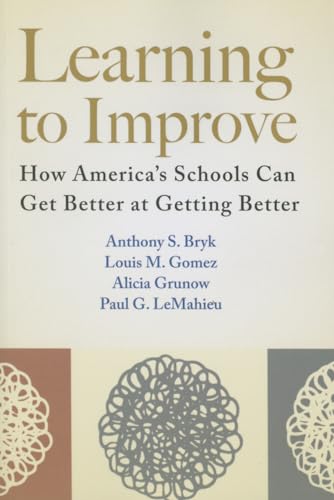Learning to Improve
How America's Schools Can Get Better at Getting Better
Anthony S. Bryk; Louis M. Gomez; Alicia Grunow; Paul G. LeMahieu
BOOK REVIEW

Learning to Improve: How America's Schools Can Get Better at Getting Better is an intellectual beacon in the murky waters of educational reform. Authored by a stellar team comprising Anthony S. Bryk, Louis M. Gomez, Alicia Grunow, and Paul G. LeMahieu, this book isn't just a collection of theories; it's a powerful call to action, challenging the very foundations of how we perceive quality and improvement in American schools.
What sets this book apart? It dismantles the monotonous cycles of educational disappointment, suggesting instead that schools must learn to be adaptive, agile, and continuously evolving entities. Through rich vignettes and empirical research, it portrays schools not as static institutions bound by tradition but as dynamic organizations primed for growth and transformation. This is not merely about "getting better"; it's about reimagining what "better" really means in the context of education.
Imagine you are a teacher-passionate, dedicated, yet frustrated by the systemic barriers that impede progress. You implement new strategies, try innovative approaches, and pour your heart into your students. Yet, without a structured framework for reflection and iteration, your efforts can feel futile. This is the crux of Learning to Improve. It not only acknowledges your struggles but also provides the roadmap to meaningful change. Bryk and his colleagues emphasize a collaborative model, advocating for communities of practice where educators can come together to share insights, reflect on their experiences, and iterate on their methodologies. This collective journey transforms every small success and failure into invaluable lessons for all.
Moreover, the authors distill complex ideas into relatable narratives, taking readers on a journey through successful case studies from schools that have embraced this mindset. You'll immediately feel a twinge of hope as you read about teachers who, once demoralized and defeated, became transformative leaders in their classrooms. Their stories spark inspiration and, dare I say, a longing for that kind of impact in your own educational environment.
Critics of the book, however, voice a common concern: How applicable is this model across diverse educational landscapes? They argue that while the frameworks may work in certain contexts, the unique challenges faced by underfunded and under-resourced schools cannot be overlooked. There's a fear that without a scalable approach for equity, the strategies presented might only serve privileged institutions. This debate ignites a passionate discussion within the educational community-one that the book itself catalyzes, pushing readers to confront the inequities that persist in our educational systems.
As we navigate the complexities of education reform in a polarized era, Bryk and his co-authors shine a light on the importance of a growth mindset-not just for students but for educators and administrators alike. The core idea is simple but profound: schools must embrace continuous improvement by harnessing the power of collaboration, data analysis, and reflective practices. This is revolutionary! We're not merely trying to fix a broken system; we're collectively charting a new course toward excellence.
You may wonder who has been influenced by this book. Visionaries in teaching and educational policy have leveraged its insights to foster systemic changes. The ripple effects can be felt in classrooms around the nation, as educators start to rethink their approach to instruction and assessment. This isn't just a book that has gathered dust on the shelves; it's a movement-fueling conversations and inspiring initiatives aimed at making American education not just tolerable but extraordinary.
In a world teetering on the edge of educational reform, Learning to Improve doesn't just provide a glimmer of hope; it hands us a toolkit to dismantle the shackles of mediocrity. The question isn't if you should engage with this text but how quickly you can dive into its pages, absorb its wealth of knowledge, and join the charge toward a better future for America's schools. 🌟
So, if you haven't yet navigated this transformative work, let it be known: the future of education is here, and it demands your attention. Don't be the one left behind in complacency. Embrace the challenge, for Learning to Improve is your key to catalyzing change in an educational landscape ripe for innovation. The question remains-are you ready to rise to the occasion?
📖 Learning to Improve: How America's Schools Can Get Better at Getting Better
✍ by Anthony S. Bryk; Louis M. Gomez; Alicia Grunow; Paul G. LeMahieu
🧾 280 pages
2015
#learning #improve #americas #schools #better #getting #better #anthony #bryk #AnthonySBryk #louis #gomez #LouisMGomez #alicia #grunow #AliciaGrunow #paul #lemahieu #PaulGLeMahieu